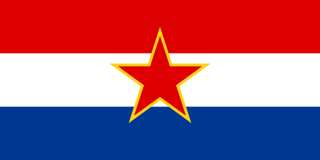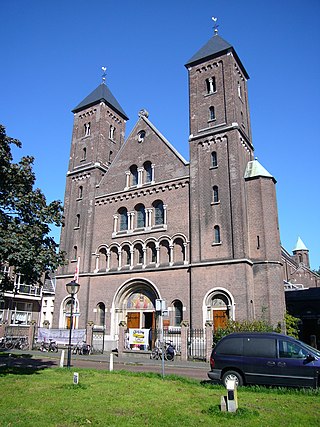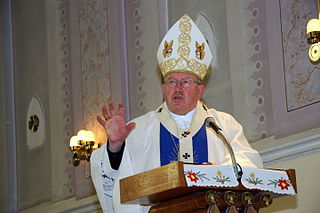
Yugoslavia was a country in Southeast and Central Europe that existed from 1918 to 1992. It came into existence following World War I, under the name of the Kingdom of Serbs, Croats and Slovenes from the merger of the Kingdom of Serbia with the provisional State of Slovenes, Croats and Serbs, and constituted the first union of South Slavic peoples as a sovereign state, following centuries of foreign rule over the region under the Ottoman Empire and the Habsburg monarchy.

Catholic clergy involvement with the Ustaše covers the role of the Croatian Catholic Church in the Independent State of Croatia (NDH), a Nazi puppet state created on the territory of Axis-occupied Yugoslavia in 1941.

Aloysius Viktor Stepinac was a Croat prelate of the Catholic Church. Made a cardinal in 1953, Stepinac served as Archbishop of Zagreb from 1937 until his death, a period which included the fascist rule of the genocidal Ustaše regime with the support of the Axis powers from 1941 to 1945 during World War II.

Josip Bozanić is a Croatian prelate of the Catholic Church who was the Archbishop of Zagreb from 1997 to 2023. He was previously Bishop of Krk from 1989 to 1997. He was made a cardinal in 2003.

The Catholic Church in Croatia is part of the worldwide Catholic Church that is under the spiritual leadership of the Pope. The Latin Church in Croatia is administered by the Croatian Bishops' Conference centered in Zagreb, and it comprises five archdioceses, 13 dioceses and one military ordinariate. Dražen Kutleša is the Archbishop of Zagreb.

The Catholic Church in Bosnia and Herzegovina is a part of the worldwide Catholic Church under the spiritual leadership of the pope in Rome.

In late 19th and throughout the 20th century, the establishment of a Balkan Federation had been a recurrent suggestion of various political factions in the Balkans. The concept of a Balkan federation emerged in the late 19th century among left-wing political forces in the region. The central aim was to establish a new political unity: a common federal republic unifying the Balkan Peninsula on the basis of internationalism, socialism, social solidarity, and economic equality. The underlying vision was that, despite differences among the region's ethnic groups, the historical need for emancipation was a common basis for unification.

The Socialist Republic of Croatia, commonly abbreviated as SR Croatia and referred to as simply Croatia, was a constituent republic and federated state of the Socialist Federal Republic of Yugoslavia. By its constitution, modern-day Croatia is its direct continuation.

The Union of Utrecht of the Old Catholic Churches, most commonly referred to by the short form Union of Utrecht (UU), is a federation of Old Catholic Churches, nationally organized from schisms which rejected Roman Catholic doctrines of the First Vatican Council in 1870; its member churches are not in communion with the Roman Catholic Church.

Krunoslav Stjepan Draganović was a Bosnian Croat Catholic priest associated with the ratlines which aided the escape of Ustaše war criminals from Europe after World War II while he was living and working at the College of St. Jerome in Rome. He was an Ustaša and a functionary in the fascist puppet state called the Independent State of Croatia.

The Catholic Church in Serbia is part of the worldwide Catholic Church under the spiritual leadership of the pope in Rome. There are 356,957 Catholics in Serbia according to the 2011 census, which is roughly 5% of the population. Estimates in 2020 suggested that the figure had risen to 5.5-6%.

The prime minister of Yugoslavia was the head of government of the Yugoslav state, from the creation of the Kingdom of Serbs, Croats and Slovenes in 1918 until the breakup of the Socialist Federal Republic of Yugoslavia in 1992.
Croatia held an independence referendum on 19 May 1991, following the Croatian parliamentary elections of 1990 and the rise of ethnic tensions that led to the breakup of Yugoslavia. With 83 percent turnout, voters approved the referendum, with 93 percent in favor of independence. Subsequently, Croatia declared independence and the dissolution of its association with Yugoslavia on 25 June 1991, but it introduced a three-month moratorium on the decision when urged to do so by the European Community and the Conference on Security and Cooperation in Europe through the Brioni Agreement. The war in Croatia escalated during the moratorium, and on 8 October 1991, the Croatian Parliament severed all remaining ties with Yugoslavia. In 1992, the countries of the European Economic Community granted Croatia diplomatic recognition and Croatia was admitted to the United Nations.

Yugoslavia was a state concept among the South Slavic intelligentsia and later popular masses from the 19th to early 20th centuries that culminated in its realization after the 1918 collapse of Austria-Hungary at the end of World War I and the formation of the Kingdom of Serbs, Croats and Slovenes. However, from as early as 1922 onward, the kingdom was better known colloquially as Yugoslavia ; in 1929 the name was made official when the country was formally renamed the "Kingdom of Yugoslavia".

Stanislav Hočevar is a Slovenian Roman Catholic prelate. He was the archbishop of the Archdiocese of Belgrade in Serbia between 2001 and 2022. He was also the president of the International Bishops' Conference of Saints Cyril and Methodius between 2001 and 2011.

The Croatian Bishops' Conference (HBK) is an episcopal conference of the Catholic Church in Croatia. The Conference was founded on May 15, 1993 after Croatia regained its independence after the breakup of Yugoslavia in the early 1990s, which consequentially led to the abolition of the Bishops' Conference of Yugoslavia. HBK is composed of all active and retired bishops; currently 32.

Medjugorje, a village in the south of Bosnia and Herzegovina, has been the site of alleged apparitions of the Blessed Virgin Mary since 24 June 1981. Various officials of the Catholic Church have attempted to discern the validity of these Marian apparitions in order to provide guidance to potential devotees and pilgrims. On 7 December 2017, it was reported that Archbishop Hoser, Pope Francis' envoy to Medjugorje, announced that official pilgrimages are allowed, stating, "dioceses and other institutions can organize official pilgrimages." This pilgrimage was officially authorized by the Holy See in May 2019. The approval was not intended to signify recognition of the apparitions, but acknowledge the faith and pastoral needs of the pilgrims. In Aug 2024, Pope Francis granted approval for devotions linked to Medjugorje: "The Dicastery for the Doctrine of the Faith, with the assent of Pope Francis, grants approval for devotion linked to Medjugorje, recognizing the abundant spiritual fruits received at the Sanctuary of the Queen of Peace without making a declaration on the supernatural character of the Marian apparitions."
Franciscan Province of Herzegovina of the Ascension of the Blessed Virgin Mary is a province of the Catholic religious order of the Order of Friars Minor, commonly known as Franciscans. It was established in 1843 when it seceded from the Franciscan Province of Bosna Srebrena. Its headquarters are in Mostar.

The Dubrovnik chess set is a style of chess pieces. These chessmen are considered to have significant historical importance and are regarded as a timeless design classic. Over the decades several variants of the Dubrovnik chessmen were designed.

Berislav Grgić is a Bosnian Croat bishop who served between 2008 and 2023 in Norway as the Roman Catholic Territorial Prelate of Tromsø, the northernmost Catholic bishopric in the world. Grgić fled Bosnia and Herzegovina during the Bosnian War, arriving in Norway as a refugee and eventually becoming one of the highest-ranking officials of the Catholic Church in Norway.

















